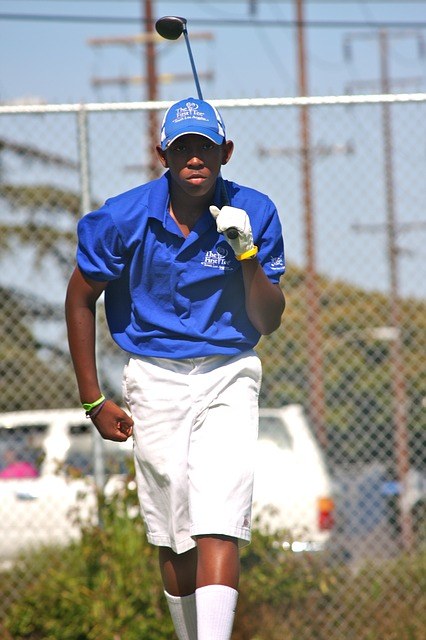Golf fitting tends to push people one of two ways. Either it is the only way to play and if your clubs aren’t fit, you are wasting your time. Or it is at best a sort of pseudo-science and at worst next door to witch craft and only good for separating a golfer from his money. I have some strong opinions and in all honesty have played as well (or badly) with off the rack and made to measure clubs. If you are hesitating, you might be interested in learning what actually goes into the process of how to fit a golf club.
Fitting is actually a pretty broad subject and open to interpretation. For example, if I go to my local golf shop and they sell me a longer putter because I am tall, is this fitting? On the other extreme, do I have to go through a couple of days of hitting balls and measurements from a club fitter in order to have a handmade set of miura blades unique to me? Actually, these are both valid options in terms of what fitting is in my opinion. I am not saying the first is perfect or that the second is necessary, but both are certainly possible.
In fact, they both follow the same basic premise: a golf club will be different depending on the person who is going to be using it. The difference is simply one of detail. On the one hand, a basic correlation between height and club length (which might not actually be correct at all, but that’s another story.) On the other, a detailed look at everything from build and physical attributes to swing characteristics and desired shot shape and ball flight. So let’s look at some of the things that are involved in fitting a club at whatever degree.
Static Measurements
Static measurements are generally a starting point for virtually any fitting process. This might even be the only criterion in some cases. I am a classic example of someone who has a static fitting that is well outside the norm. I am 1m98 tall (6 ft 6 inches.) You would assume that I am going to ‘need’ a longer golf club. This is generally true although i also often play with standard clubs too and really, the difference in terms of ball striking is inexistent although the issue of comfort and wear and tear on my body is something else.
Height isn’t the only thing that relates to club length. The other common measurement that is taken is something called wrist to floor. This is just as it sounds. Stand straight up, generally in shoes and measure the distance from the crease in the wrist all the way to the floor. This often goes with height. To come back to my example, my wrist to floor is around 1m or 40 inches which is big.
-
Is 18 Holes Too Much
Golf has been around for centuries, but the tradition of playing 18 holes wasn’t always a thing. Originally, courses had varied numbers of holes, until the rule of 18 started taking over in the mid-1700s, primarily to standardize the competition format. But let’s face it, what worked in 1764 might not fit into our busy…
These first two measurements are going to be used to at least start to determine both club length and lie angle. Lie angle is the angle between the bottom of the clubhead and the shaft. These two numbers go together for logical reasons. It is possible to use a combination of both to get a club that feels right and fits a golfer. I have a friend who is a similar height to me. He is fine playing clubs that are over length and also doesn’t mind standard length clubs that are very upright (for him, around 4 degrees or so.) He really struggles with completely standard.
Length and Lie
Be careful with perceived fitting wisdom here. The fact that you are using over length clubs doesn’t have to go hand in hand with upright lie angles. It might and many taller golfers play say 1 inch over and a couple of degrees upright, but it might not at all.
This is going to be the difference between a quick check of measurements and a real fitting.
I find that Ping is quite interesting in this respect. They have their colour chart which uses wrist to floor and height to give a colour code for irons. This colour code corresponds to a lie angle and the chart gives a length too. However, if you go through a fitting with Ping, this merely gives the fitter a starting point and he will work with you to find out what is best dynamically rather than just statically.
The next basic fitting element is often grip size. This didn’t use to be such big thing. Almost everyone played regular grips and maybe a midsize for some. Nowadays, the range and style of grips is incredible. A fitter, whether in a golf shop or from a certified club builder will probably measure hand and finger length to find a reasonable option. Once again though, this is a personal thing. Since Bryson Popularized his huge Jumbo Max grips, golfers are looking at different sizes for everything from curing a hook to dealing with hand pain from arthritis.
It does feel like the golfing advertisers have jumped on this a little bit to push some of the different grip options out there. However, it is also something that is worth looking at because it can have real benefits in terms of comfort and performance. I currently use jumbo grips on my irons which I do find to be more comfortable for my large hands and possible at little easier on a couple of joint problems.
Shaft Fitting Sorcery
So far, the fitting process is fairly standard. Measure stuff, find and option that fits and take it from there. An experienced fitter may vary quite a bit from the original specs but there is a clearly definable starting point. When we start looking at shaft, all bets are off and we can come pretty close to club fitting sorcery!
This is a (slight) exaggeration, but fitting for shaft is probably as much art as science. Getting something that is more or less heavy or stiff, has a slightly different bend profile, less torque, ascending weight, counterbalanced…. there are a lot of options out there.
Traditionally, this was a simple case of swing speed or even handicap. Everyone was playing heavy steel and you would fit somewhere along the range from an extra stiff to a regular. Now, the options are even more vast than is the case for grips!
I do think that shafts are important. However, sometimes the search for a shaft that decreases spin by 200 revs and increases launch angle by 1 degree makes me smile. Even very good golfers have far more variance from shot to shot than this based on swing and strike so it always seems like something of a waste of time.
This doesn’t mean that we should ignore it though. Many golfers would find the game a lot more enjoyable if they had the opportunity to try a lightweight steel or graphite shaft that made their life on course easier. Even off the rack clubs generally have a great range of shaft options so it is a shame not to try to get at least in the right ballpark.
You might have noticed that we haven’t talked about the thing that is seen as being the most important variable of all for many (but not for me.) That is the club head itself. I think that this should be more a matter of visual choice for most of us, certainly in the shorter clubs. For example, if a golfer has all his ducks lined up in terms of lie, length, grip and flex, the actual clubhead isn’t going to make a huge difference. Obviously, loft will be important in terms of the distance he or she will get out of the club, but it is perhaps more about finding something that instills confidence behind the ball. For one golfer, that might be butter knife blades, for another a hugely offset hybrid iron. Both are fine.
Anyone Can Learn How to Fit a Golf Club
Fitting is one of those subjects that tend to incite all sorts of wrath on golf forums. Whether it is the only way to play or basically some sort of con, opinions vary wildly as the insults fly. I think it is an interesting process to go through because it teaches us quite a lot about equipment itself and our own games. Whether your fitter is a golf store shop assistant or a club builder on the PGA tour, the elements they look at (length, lie, grip, shaft, club head) really aren’t that different. The level of detail and skill in interpreting this data can of course be worlds apart.




